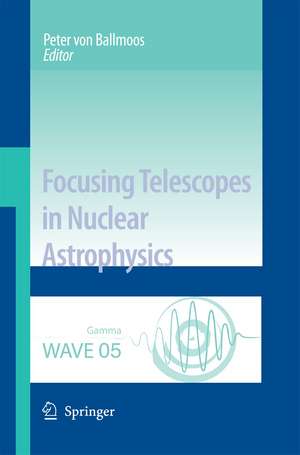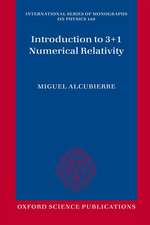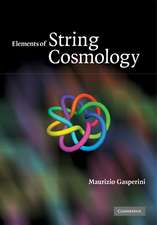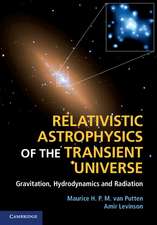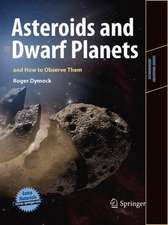Focusing Telescopes in Nuclear Astrophysics
Editat de Peter Ballmoosen Limba Engleză Paperback – 28 noi 2014
| Toate formatele și edițiile | Preț | Express |
|---|---|---|
| Paperback (1) | 650.86 lei 6-8 săpt. | |
| SPRINGER NETHERLANDS – 28 noi 2014 | 650.86 lei 6-8 săpt. | |
| Hardback (1) | 661.32 lei 6-8 săpt. | |
| SPRINGER NETHERLANDS – 20 dec 2006 | 661.32 lei 6-8 săpt. |
Preț: 650.86 lei
Preț vechi: 765.72 lei
-15% Nou
Puncte Express: 976
Preț estimativ în valută:
124.54€ • 130.38$ • 103.05£
124.54€ • 130.38$ • 103.05£
Carte tipărită la comandă
Livrare economică 05-19 aprilie
Preluare comenzi: 021 569.72.76
Specificații
ISBN-13: 9789401783132
ISBN-10: 9401783136
Pagini: 512
Ilustrații: VIII, 503 p.
Dimensiuni: 155 x 235 x 27 mm
Greutate: 0.71 kg
Ediția:2006
Editura: SPRINGER NETHERLANDS
Colecția Springer
Locul publicării:Dordrecht, Netherlands
ISBN-10: 9401783136
Pagini: 512
Ilustrații: VIII, 503 p.
Dimensiuni: 155 x 235 x 27 mm
Greutate: 0.71 kg
Ediția:2006
Editura: SPRINGER NETHERLANDS
Colecția Springer
Locul publicării:Dordrecht, Netherlands
Public țintă
Professional/practitionerCuprins
Scientific Requirements and Prospects.- Prospects in space-based gamma-ray astronomy.- Annihilation of positrons in the Galaxy.- Prospects and requirements for measurements of extragalactic ?-ray lines.- Non-thermal cosmic backgrounds and prospects for future high-energy observations of blazars.- Rolling down from the 30 keV peak: Modelling the hard X-ray and ?-ray backgrounds.- Focusing supernova gamma rays.- Nucleosynthesis in nova explosions: Prospects for its observation with focusing telescopes.- Puzzles and potential for gamma-ray line observations of solar flare ion acceleration.- Gamma-ray Optics.- The INTEGRAL — HESS/MAGIC connection: A new class of cosmic high energy accelerators from keV to TeV.- Replicated nickel optics for the hard-x-ray region.- Small d-spacing WC/SiC multilayers for future hard X-ray telescope designs.- Design aspects of grazing angle multilayer mirrors for soft ?-rays.- Progress toward light weight high angular resolution multilayer coated optics.- InFOC?S hard X-ray imaging telescope.- Development of the HEFT and NuSTAR focusing telescopes.- The SIMBOL-X hard X-ray mission.- Laue diffraction lenses for astrophysics: Theoretical concepts.- Laue diffraction lenses for astrophysics: From theory to experiments.- Mosaic and gradient SiGe single crystals for gamma ray Laue lenses.- Copper mosaic crystals for Laue lenses.- High diffraction efficiency, broadband, diffraction crystals for use in crystal diffraction lenses.- An “ESA-affordable” Laue-lens.- Optical properties of Laue lenses for hard X-rays (> 60 keV).- Development of a new photon diffraction imaging system for diagnostic nuclear medicine.- HAXTEL: A Laue lens telescope development project for a deep exploration of the hard X-ray sky (>60 keV).- CLAIRE: First light for agamma-ray lens.- MAX, a Laue diffraction lens for nuclear astrophysics.- The gamma ray lens — an ESA technology reference study.- Gamma ray Fresnel lenses — why not?.- Development of ground-testable phase fresnel lenses in silicon.- Multiwavelength focusing with the Sun as gravitational lens.- Focal Plane Instrumentation.- A Si/CdTe Compton Camera for gamma-ray lens experiment.- New scintillators for focal plane detectors in gamma-ray missions.- A focal plane detector design for a wide-band Laue-lens telescope.- Polarisation measurements with a CdTe pixel array detector for Laue hard X-ray focusing telescopes.- Simulated performance of dedicated Ge-strip Compton telescopes as ?-lens focal plane instrumentation.- Monte Carlo study of detector concepts for the MAX Laue lens gamma-ray telescope.- Performance of the Nuclear Compton Telescope.- The Compton and pair creation telescope MEGA.- Ground Facilities and Flight Systems for Focusing Telescopes.- The MPE X-ray test facility PANTER: Calibration of hard X-ray (15–50 kev) optics.- The Ferrara hard X-ray facility for testing/calibrating hard X-ray focusing telescopes.- SIMBOL-X: An hard X-ray formation flying mission.- Distributed space segment for high energy astrophysics: Similarities and specificites.- The CLAIRE gondola: Testing the first gamma-ray lens on a stratospheric balloon.- Recent advances and low cost concept for the gamma-ray lens project MAX.- Small-sat platforms and formation flying: An opportunity for the gamma ray telescope MAX.- MAX: Formation flying for nuclear astrophysics.- Formation flying for a Fresnel lens observatory mission.
Notă biografică
Peter von Ballmoos est né en 1956 à Zürich. Après des études de physique à l'Ecole Polytechnique Fédérale de Zürich, un doctorat à l'Université Technique de Munich, et des post-docs outre Atlantique, il a été élu professeur d'astrophysique à l'Université de Toulouse en 1991.
Au sein du Centre d'Etudes Spatiales des Rayonnements de Toulouse, il mène des recherches en astrophysique nucléaire - en particulier l'instrumentation, l'observation et l'interprétation des raies gamma nucléaires. L’observation des raies gamma nucléaires est une des clés aux questions fondamentales sur la structure et l'évolution de l'Univers, et particulièrement sur les cycles de vie de la matière et du comportement de la matière dans des conditions extrêmes. Peter von Ballmoos est co-responsable du projet Spectromètre INTEGRAL de l'ESA et responsable des projets "lentille gamma" du CNES (CLAIRE, MAX).
Au sein du Centre d'Etudes Spatiales des Rayonnements de Toulouse, il mène des recherches en astrophysique nucléaire - en particulier l'instrumentation, l'observation et l'interprétation des raies gamma nucléaires. L’observation des raies gamma nucléaires est une des clés aux questions fondamentales sur la structure et l'évolution de l'Univers, et particulièrement sur les cycles de vie de la matière et du comportement de la matière dans des conditions extrêmes. Peter von Ballmoos est co-responsable du projet Spectromètre INTEGRAL de l'ESA et responsable des projets "lentille gamma" du CNES (CLAIRE, MAX).
Textul de pe ultima copertă
This volume is the first of its kind on focusing gamma-ray telescopes. Forty-eight refereed papers provide a comprehensive overview of the scientific potential and technical challenges of this nascent tool for nuclear astrophysics. The book features articles dealing with pivotal technologies such as grazing incident mirrors, multilayer coatings, Laue- and Fresnel-lenses - and even an optic using the curvature of space-time.
The volume also presents an overview of detectors matching the ambitious objectives of gamma ray optics, and facilities for operating such systems on the ground and in space. The extraordinary scientific potential of focusing gamma-ray telescopes for the study of the most powerful sources and the most violent events in the Universe is emphasized in a series of introductory articles.
Practicing professionals, and students interested in experimental high-energy astrophysics, will find this book a useful reference
The volume also presents an overview of detectors matching the ambitious objectives of gamma ray optics, and facilities for operating such systems on the ground and in space. The extraordinary scientific potential of focusing gamma-ray telescopes for the study of the most powerful sources and the most violent events in the Universe is emphasized in a series of introductory articles.
Practicing professionals, and students interested in experimental high-energy astrophysics, will find this book a useful reference
Caracteristici
The first book of its kind on focusing gamma-ray telescopes
